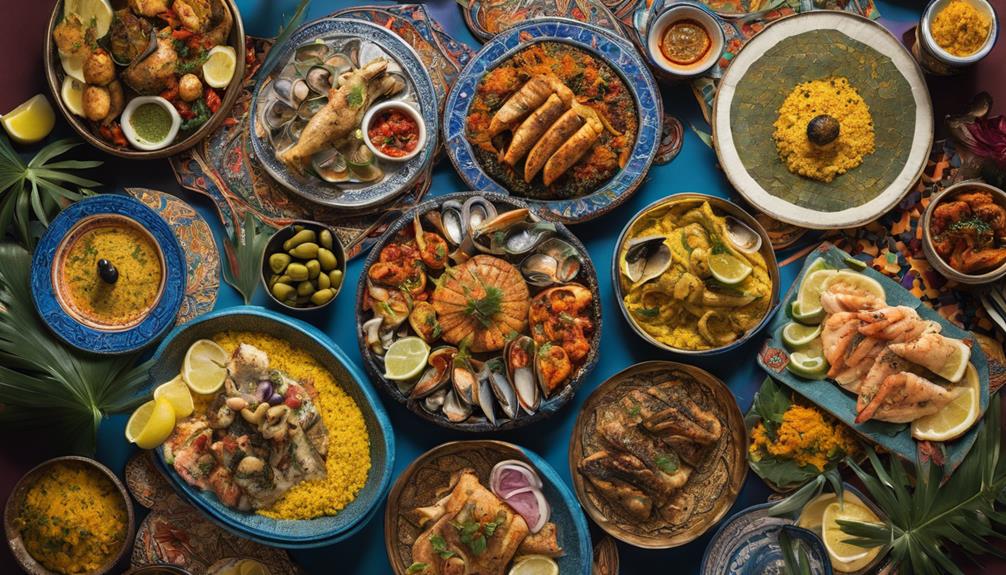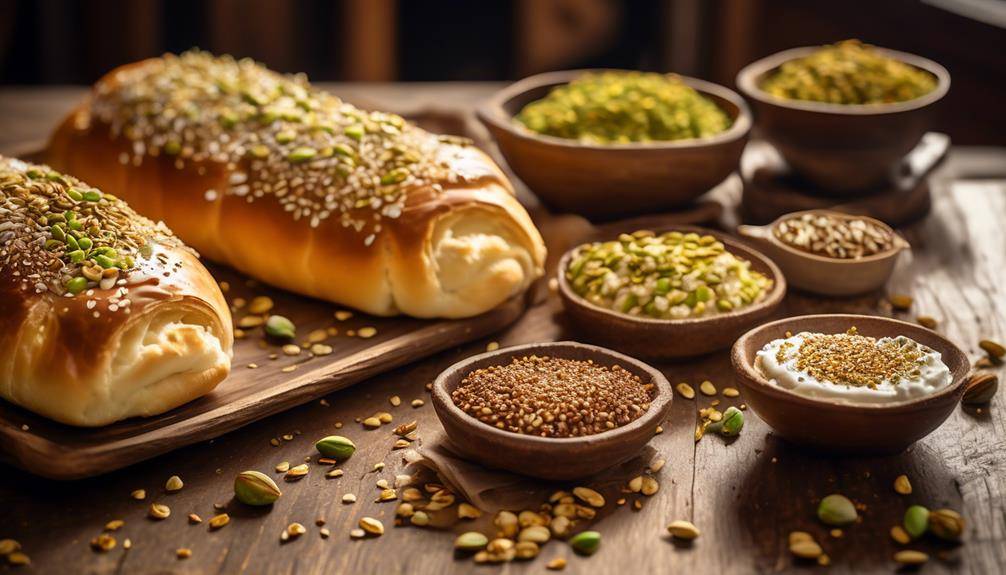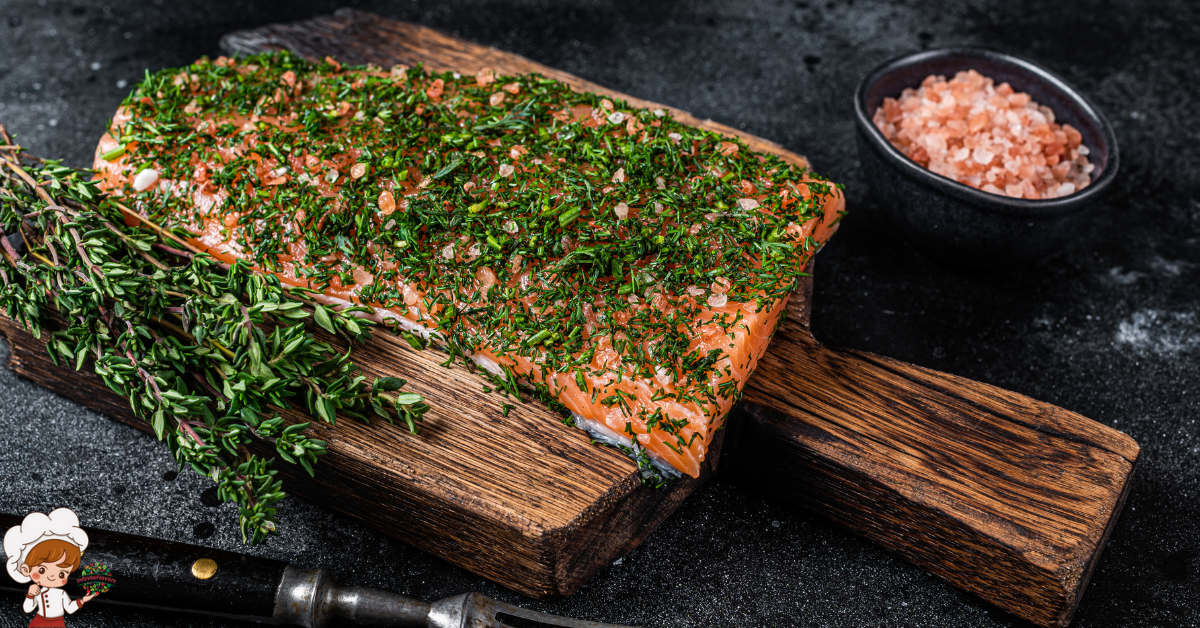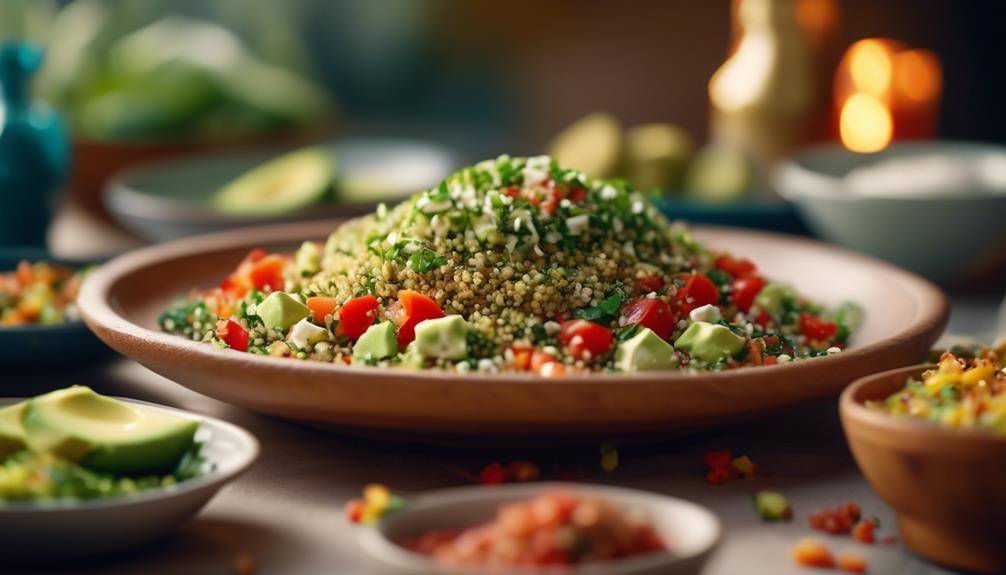The Best Middle Eastern Seafood Specialties

Middle Eastern seafood specialties are a delightful blend of flavors and traditions. You’ll love dishes like the vibrant fish tagine, fragrant with spices and served over fluffy couscous. Grilled shrimp skewers offer a smoky, tender treat, while spicy fish kebabs elevate any meal with their robust taste. Stuffed squid shines with a savory filling, and baked fish with tahini is a creamy delight. Don’t forget the clams with lemon and herbs, perfect for a light yet flavorful dish. Each specialty brings a unique twist, inviting you to explore the deep-rooted flavors of this rich cuisine further.
Traditional Fish Tagine
When you think of Middle Eastern cuisine, the traditional fish tagine stands out as a vibrant and flavorful dish. This culinary masterpiece combines fresh fish with aromatic spices, creating a meal that tantalizes your taste buds. To make it truly exceptional, mastering fish marination techniques is essential. You’ll want to marinate the fish in a blend of spices like cumin, coriander, and paprika, along with a splash of lemon juice and olive oil. This not only enhances the fish’s natural flavors but also helps to tenderize it, ensuring a succulent bite every time.
Once your fish is marinated, it’s time to explore tagine cooking methods. A tagine is a traditional Moroccan cookware, characterized by its conical lid, which allows steam to circulate while keeping the ingredients moist. Begin by sautéing onions, garlic, and your choice of vegetables in the tagine pot. Then, layer the marinated fish atop the sautéed mix, adding additional spices and herbs to complement the dish. Cover the tagine and let it cook slowly over low heat. The gentle cooking process allows the flavors to meld beautifully, creating a rich, aromatic sauce that clings to each piece of fish.
Serve your fish tagine with fluffy couscous or warm bread to soak up the delightful sauce. Enjoying this dish is not just a meal; it’s an experience that captures the essence of Middle Eastern hospitality.
Grilled Shrimp Skewers
Grilled shrimp skewers are a delightful addition to any Middle Eastern feast, offering a perfect blend of smoky flavors and tender, juicy seafood. To make the most of your skewers, start with fresh, deveined shrimp. You’ll want to marinate them for at least 30 minutes to amplify their flavor. There are countless marinade variations you can try, such as a zesty mix of olive oil, lemon juice, garlic, and spices like cumin and coriander. If you’re feeling adventurous, consider adding some yogurt for creaminess or a splash of pomegranate molasses for a sweet-tart twist.
When it comes to grilling, there are a few tips you should keep in mind. First, soak wooden skewers in water for about 30 minutes before using them to prevent burning. If you’re using metal skewers, you can skip this step. Preheat your grill to medium-high heat, allowing those grill marks to develop while guaranteeing even cooking. Thread the shrimp onto the skewers, leaving a little space between each piece to guarantee proper heat circulation.
As you grill, keep an eye on the shrimp; they cook quickly—usually in about 2-3 minutes per side. Once they turn pink and opaque, they’re ready to come off the grill. Serve your grilled shrimp skewers with a sprinkle of fresh herbs and a side of tangy sauce for dipping. You’ll have a flavorful dish that’s sure to impress your guests!
Spicy Fish Kebabs
Spicy fish kebabs are a vibrant and flavorful dish that can elevate any Middle Eastern meal. You’ll love how easy they are to prepare and how they bring a burst of flavor to your table. Start by selecting firm, white fish like cod or snapper, which hold up well on the grill.
For the perfect marinade, combine olive oil, lemon juice, garlic, cumin, coriander, and a touch of chili powder. This blend not only adds spice but also maintains your fish moist while it cooks. Let your fish marinate for at least 30 minutes, allowing the flavors to penetrate deeply. If you’re feeling adventurous, experiment with different herbs and spices to personalize your marinade recipes.
When it’s time to grill, make sure your grill is preheated to medium-high heat. This guarantees that the kebabs cook evenly and develop a nice char. Thread the marinated fish onto soaked wooden skewers or metal skewers, alternating with vibrant veggies like bell peppers and onions. This not only adds color but also enhances the flavor profile.
Remember some grilling tips: keep an eye on the kebabs, turning them gently to avoid breaking the fish apart. They’ll typically take about 10-12 minutes to cook, depending on the thickness of your pieces. Once they’re done, serve them with a zesty yogurt sauce or a fresh tabbouleh salad for a complete meal that’s sure to impress. Enjoy your culinary adventure with these spiced delights!
Stuffed Squid
Have you ever tried stuffed squid? This delightful dish, known as “calamari ripieni” in some cultures, is a staple in Middle Eastern cuisine that will elevate your seafood experience. The key to perfect stuffed squid lies in the squid preparation; you need to clean and prepare the squid carefully, ensuring the tubes are intact for stuffing.
Once you’ve prepped the squid, the real fun begins with the stuffing variations. Traditionally, a mixture of rice, herbs, and spices forms the base of the stuffing. You can use fragrant herbs like parsley, dill, or mint to add freshness, and spices such as cumin or paprika for a touch of warmth. Some people even include ground meat, like lamb or beef, to make the dish heartier.
To stuff the squid, simply fill each tube with your prepared mixture, leaving a little space at the top to allow for expansion during cooking. You can use toothpicks to secure the openings, ensuring your stuffing stays put. After that, you can grill, bake, or simmer the stuffed squid, allowing the flavors to meld beautifully.
When it comes to serving, drizzle with a squeeze of lemon or a flavorful sauce to enhance the dish’s taste. Stuffed squid is not only delicious but also visually striking, making it perfect for sharing at gatherings or enjoying as a special home-cooked meal. Give it a try, and you might just find your new favorite seafood dish!
Baked Fish With Tahini
There’s something irresistible about baked fish with tahini, a dish that beautifully combines the delicate flavors of fresh fish with the rich, nutty taste of tahini. When you prepare this dish, consider using regional fish like sea bass or snapper, as they hold up well to baking and absorb the flavors beautifully.
Start by marinating your fish in a mixture of tahini, lemon juice, garlic, and a blend of Middle Eastern spices like cumin and sumac. Not only do these fish marinades enhance the flavor, but tahini benefits your health too, providing healthy fats and essential nutrients.
When it comes to baking techniques, verify your oven is preheated to the right temperature for even cooking. Place your marinated fish on a lined baking sheet and drizzle any remaining tahini sauce over the top. Bake until the fish flakes easily with a fork, typically around 20 to 25 minutes, depending on thickness.
As for serving styles, you can present your baked fish on a bed of couscous or alongside roasted vegetables for a complete meal. Pair it with a fresh salad or a yogurt sauce for added depth. The nutritional value of this dish is impressive, packed with protein, healthy fats, and vitamins.
Embracing the cultural significance of this dish, you’ll not only savor a delicious meal but also connect with the rich culinary traditions of the Middle East. Meal prep becomes easy with this dish, allowing you to enjoy leftovers that taste even better the next day.
Seafood Paella
When you think about Seafood Paella, it’s all about those flavorful ingredient combinations that make every bite a delight. You’ll appreciate the cooking techniques that bring out the best in seafood and rice, creating a dish that’s both hearty and vibrant. Plus, exploring regional variations will show you how this classic can take on different flavors and styles across the Middle East.
Flavorful Ingredient Combinations
Seafood paella is a vibrant dish that brings together an array of flavorful ingredient combinations, showcasing the rich culinary traditions of the Mediterranean. You’ll find that the magic lies in the spice blends you choose, which can elevate your dish with bold flavor profiles. Experiment with ingredient pairings like saffron and smoked paprika, or try adding garlic for depth.
Using seasonal seafood, such as shrimp, mussels, and squid, guarantees freshness and enhances the overall taste. To achieve contrasting textures, consider including tender vegetables alongside your seafood, offering a delightful crunch. Aromatic herbs like parsley and cilantro provide a fragrant finish, while citrus accents from lemon or lime brighten the dish.
Don’t overlook marination techniques; a simple soak in olive oil and spices can transform your seafood, making it more succulent. As for cooking oils, opt for high-quality olive oil to add richness. Finally, think about presentation styles: serving paella in its pan creates an inviting communal dish, enticing guests to engage. With these flavorful ingredient combinations, your seafood paella will not only taste incredible but also look stunning on the table.
Cooking Techniques Explained
To make a remarkable seafood paella, mastering the right cooking techniques is essential. Start by choosing fresh seafood like shrimp, mussels, and calamari, as their quality can greatly impact your dish. One effective technique is sous vide, which allows you to cook seafood to perfection while retaining moisture and flavor. Seal your seafood in a vacuum bag, submerge it in a water bath at a precise temperature, and let it cook gently before adding it to your paella.
Next, consider incorporating smoking techniques to elevate the flavors in your paella. You can use a stovetop smoker or even a grill to infuse your seafood with a rich, smoky aroma. Simply season your seafood, place it in the smoker for a short time, and then combine it with other ingredients.
When preparing the rice, confirm you develop a socarrat, the crispy layer at the bottom, by allowing it to cook undisturbed. This technique adds texture and enhances the overall experience of your paella. By mastering these cooking techniques, you’ll create a delicious seafood paella that stands out and impresses your guests.
Regional Variations Explored
Exploring regional variations of seafood paella reveals how local ingredients and cultural influences shape this iconic dish. Each region brings its own twist, influenced by market availability and culinary traditions. In coastal areas, fresh seafood is abundant, and you’ll often find shellfish, squid, and fish sourced from sustainable fishing practices.
Regional spices play a significant role, with saffron often replaced by local herbs, reflecting seasonal variations and enhancing flavor profiles. Cooking methods also differ; some prefer the traditional open flame, while others might use modern techniques for convenience.
Family recipes passed down through generations showcase the beauty of traditional preservation, ensuring that each generation honors its roots while adapting to contemporary tastes. You might encounter variations that include local vegetables or grains, further emphasizing the region’s identity.
As you explore these diverse versions of seafood paella, remember that each dish tells a story of the people, their culture, and their relationship with the sea. Whether you savor a Valencia-style paella or a unique twist from the Middle East, you’re experiencing a rich tapestry of culinary innovation shaped by time and tradition.
Shrimps in Garlic Sauce
When you prepare shrimps in garlic sauce, the rich flavor of garlic infuses each succulent bite. You’ll want to master a few cooking techniques to guarantee the shrimp are perfectly tender and coated in that aromatic sauce. Let’s explore how to whip up this delicious dish that’s sure to impress.
Flavorful Garlic Infusion
Garlic plays a starring role in Middle Eastern cuisine, and shrimp in garlic sauce showcases this aromatic ingredient beautifully. When you prepare this dish, you’re not just enjoying a delightful meal; you’re also embracing garlic’s numerous health benefits. Garlic is known to boost the immune system, reduce blood pressure, and provide anti-inflammatory properties.
To enhance the flavor, you’ll want to use fresh garlic, but if you’re looking to preserve its potency, consider garlic preservation methods like freezing or fermenting. These techniques allow you to enjoy garlic’s bold taste and health benefits even when it’s not in season.
As you cook your shrimp, remember that the key lies in achieving the perfect garlic infusion. You’ll want to sauté the garlic until it’s just golden, releasing its fragrant oils into the dish. This step not only intensifies the flavor but also elevates the overall experience. When paired with succulent shrimp, the result is a dish that marries the richness of seafood with the zesty punch of garlic. Serve it over rice or with warm bread, and you’ll have a meal that’s both satisfying and nourishing, embodying the essence of Middle Eastern culinary traditions.
Cooking Techniques Explained
Two essential cooking techniques elevate the dish of shrimp in garlic sauce: sautéing and deglazing. When preparing your shrimp, start by marinating them. Using effective marinade techniques not only enhances the flavor but also assists in seafood preservation. A simple mix of garlic, lemon juice, and olive oil works wonders, allowing the shrimp to absorb those vibrant flavors.
Once your shrimp are well-marinated, heat a skillet over medium-high heat and add a splash of olive oil. Sauté the shrimp for about two to three minutes on each side until they turn pink and opaque. This cooking technique guarantees that the shrimp remain tender and juicy.
After you’ve removed the shrimp, it’s time to deglaze the pan. Pour a bit of white wine or broth into the hot skillet, scraping up any browned bits stuck to the bottom. This step adds depth and richness to your garlic sauce, creating a flavorful base to toss your shrimp back into.
Combine everything, adjust seasoning, and you’ve got a delicious dish that showcases the beauty of shrimp in garlic sauce. Enjoy your culinary creation, knowing you’ve mastered these key techniques!
Fish and Rice Pilaf
For centuries, fish and rice pilaf has been a cherished dish in Middle Eastern kitchens, combining the delicate flavors of fresh seafood with the aromatic essence of seasoned rice. When you prepare this dish, you’ll want to start with a good fish marination. A mix of lemon juice, garlic, and your favorite spices can elevate the taste of the fish, ensuring it’s flavorful and moist.
Next, you’ll focus on the rice. The right rice seasoning is vital for achieving that authentic pilaf flavor. Sautéing onions and garlic in olive oil before adding the rice can create a rich base. Depending on your preference, you can explore pilaf variations by adding vegetables, nuts, or dried fruits to enhance the dish’s texture and taste.
When it comes to cooking methods, you have a couple of options. You can either steam the fish on top of the rice or bake it separately. Each method allows the fish to absorb the flavorful steam from the seasoned rice, making each bite a delight.
Pairing the pilaf with seafood is an art in itself; consider serving it alongside grilled shrimp or a tangy salad to balance the richness of the fish. As you explore different seafood pairings, you’ll discover that this dish is incredibly versatile, allowing you to adapt it to your taste. With a bit of creativity, your fish and rice pilaf will surely become a favorite in your culinary repertoire.
Clams With Lemon and Herbs
A generous serving of clams with lemon and herbs can transform an ordinary meal into a delightful seafood experience. You’ll find that clam varieties like littlenecks, cherrystones, and Manila clams each bring unique flavors and textures to your dish. Choosing the right type can elevate your dish further, so don’t hesitate to experiment.
To prepare this dish, start by thoroughly cleaning your clams to guarantee a fresh taste. Then, in a large pot, steam the clams with a splash of white wine and some minced garlic for added depth. As they open up, they release their natural juices, creating a flavorful broth. The key here is to keep it simple and let the clams shine.
Next, consider your herb pairings. Fresh parsley, basil, or cilantro can work wonders. You might also want to add a hint of dill for an aromatic twist. Combine the herbs with zesty lemon juice and zest, which not only brightens the dish but also complements the briny flavor of the clams.
Once the clams are cooked, toss them in the herb and lemon mixture. Serve them hot, perhaps accompanied by crusty bread to soak up all the delicious broth. This dish isn’t just a meal; it’s an experience that brings the taste of the Middle East right to your table. Enjoy the burst of flavors and the satisfaction of a beautifully prepared seafood dish!
Fried Fish With Zaatar
When you think about fried fish, adding zaatar takes it to another level with its unique flavor profile. You’ll want to explore different cooking techniques to achieve that perfect crispy texture, while balancing the herbal notes of zaatar. Plus, there are plenty of serving suggestions that can enhance your meal and impress your guests.
Zaatar Flavor Profile
Zaatar, with its vibrant mix of herbs and spices, infuses fried fish with an unforgettable flavor that elevates the dish to new heights. Originating from the Middle East, zaatar combines ingredients like thyme, oregano, and sumac, creating a unique taste profile that’s both earthy and tangy. When you use zaatar on fried fish, you’re not just seasoning; you’re enhancing the natural flavors of the seafood.
The aromatic blend of zaatar complements the crispy texture of the fish, adding depth that makes every bite a delight. You’ll notice how the herbal notes lift the dish, while the sumac brings a zesty brightness that cuts through the richness of the fried coating. Zaatar uses extend beyond fish, too; you can sprinkle it over vegetables, meats, or even mix it into dips.
Incorporating zaatar into your fried fish not only pays homage to its zaatar origins but also showcases its versatility. The balance of flavors makes it a perfect companion for seafood, transforming a simple fried dish into a culinary experience that’s rich in heritage and taste.
Cooking Techniques Explained
To achieve perfectly fried fish with zaatar, mastering the right cooking techniques is key. Start with marinating techniques, allowing the fish to soak in a zaatar-infused mixture. This enhances the flavor and guarantees the spices penetrate the flesh. Consider sous vide cooking for precision; it keeps the fish moist before frying, giving you a tender texture.
Next, focus on spice blending. Combine zaatar with additional spices like cumin and coriander for a unique twist. Once your fish is ready, you can use smoking methods to add a depth of flavor before frying, or even explore poaching seafood for a lighter option if desired.
Curing fish is another technique that can elevate your dish, lending a subtle saltiness that complements the zaatar. When it’s time to fry, verify your oil is hot enough for a crispy exterior. Presentation styles matter too; arrange the fried fish elegantly on a plate, garnishing with fresh herbs for a beautiful finish.
Don’t forget about flavor pairing—serving your dish with a tangy sauce or a revitalizing salad can enhance the overall experience, making your fried fish with zaatar truly unforgettable.
Serving Suggestions Ideas
Elevating your fried fish with zaatar can be a delightful experience, and there are plenty of ways to serve it that enhance its flavors. Consider pairing your fish with complementary seafood pairings like shrimp or calamari to create a well-rounded dish. Arrange your fried fish on a vibrant serving platter, letting the golden crust shine.
Garnish ideas such as fresh herbs or lemon slices can elevate the presentation, bringing brightness to the meal. For dipping sauces, think tahini or garlic sauce, which will enhance the flavor profiles of the zaatar.
When it comes to meal accompaniments, pita bread, or a fresh salad can round out your dining experience. Embrace cultural traditions by offering your fish alongside traditional Middle Eastern sides like tabbouleh or hummus.
Pay attention to dining etiquette; serving your fish family-style encourages shared enjoyment. Finally, verify you source quality ingredients, as fresh fish and authentic zaatar make all the difference. By mixing these elements, you’ll create a memorable dish that not only tastes amazing but also respects culinary traditions.
Octopus Salad
Octopus salad is a vibrant dish that showcases the unique flavors of the Mediterranean. When you immerse yourself in this delicious recipe, you’ll appreciate how the tender octopus combines beautifully with fresh ingredients, creating a revitalizing experience. The key to making a great octopus salad lies in the octopus preparation. Start by boiling the octopus until it’s tender, usually around 30 to 45 minutes, depending on its size. After cooking, let it cool, then slice it into bite-sized pieces.
Once your octopus is ready, you can get creative with the rest of the salad. Toss in some diced tomatoes, cucumbers, and red onions for a crisp texture and a burst of color. Finish with a generous drizzle of olive oil and a squeeze of lemon juice to enhance those Mediterranean flavors. Don’t forget to season with salt, pepper, and fresh herbs like parsley or mint for an aromatic touch.
Serving octopus salad cold is the best way to enjoy its delightful taste. You can serve it as a starter or as a light main dish, perfect for warm evenings. Pair it with crusty bread or a side of olives for an authentic Mediterranean experience. This dish isn’t just about the ingredients; it’s about the vibrant culinary tradition of the region. So, gather your ingredients, embrace the art of octopus preparation, and enjoy the flavorful journey that octopus salad brings to your table.
Fish Roe Dishes
Fish roe dishes offer a delightful experience that showcases the briny, rich flavors of the sea. In the Middle East, these delicacies hold a special place in culinary traditions, reflecting both regional tastes and cultural significance. You’ll find various types of roe, from the vibrant orange of salmon roe to the more subtle hues of mullet roe, each bringing unique flavors to the table.
When you explore roe preparation techniques, you’ll notice that methods vary widely. Some dishes feature fresh roe lightly salted or marinated to enhance its natural taste, while others involve smoking or drying, adding complexity. A popular dish is “Ikan Bilis” in parts of the region, where roe is fried to a crispy perfection and served alongside rice or salads, making it a beloved snack.
Roe isn’t just a culinary treat; it’s steeped in tradition. In many cultures, serving these dishes during festive occasions symbolizes prosperity and abundance. Families often gather to share meals featuring roe, reinforcing bonds and celebrating heritage.
As you savor these dishes, you’re not just enjoying the flavors but also connecting with centuries of history and tradition. Whether as a standalone dish or an accompaniment, fish roe offers a unique taste of the Middle East, reminding you of the deep connection people have with the sea and the bounty it provides. So next time you encounter fish roe on a menu, immerse yourself and relish the experience!
Frequently Asked Questions: Middle Eastern Seafood Specialties
What Are Common Spices Used in Middle Eastern Seafood Dishes?
When exploring common spices in seafood dishes, you’ll find coriander, cumin, and sumac prevalent. Regional variations influence cooking techniques and spice choices, enhancing flavors and giving each dish its unique character and aroma.
Are There Any Seafood Dishes Suitable for Vegetarians?
Sure, you can find plenty of vegetarian alternatives! Many dishes use plant-based seafood options like jackfruit or tofu to create satisfying meals. Experiment with spices and sauces to enhance those flavors and enjoy delicious, meat-free seafood-inspired dishes.
How Can I Substitute Fish in Traditional Recipes?
To substitute fish in traditional recipes, try ingredient swaps like tofu or tempeh. Use cooking techniques such as grilling or sautéing to achieve similar textures and flavors, ensuring your dish remains satisfying and delicious.
What Beverages Pair Well With Middle Eastern Seafood?
When considering beverages that complement seafood, traditional pairings often include herbal teas, pomegranate juice, or crisp white wines. These choices reflect cultural influences, enhancing flavors while creating a delightful dining experience you won’t forget.
Where Can I Find Fresh Seafood in Middle Eastern Markets?
You can find fresh seafood at local fishmongers in your area. They often prioritize sustainable sourcing, ensuring you get high-quality options. Explore nearby markets to discover a variety of fresh seafood selections tailored to your preferences.
Conclusion
In exploring Middle Eastern seafood specialties, you’ve discovered a world of vibrant flavors and unique preparations. From the aromatic fish tagine to the zesty grilled shrimp skewers, each dish offers a delightful culinary experience. Don’t shy away from trying spicy fish kebabs or stuffed squid; they’re sure to impress. Whether you’re enjoying a simple baked fish with tahini or a rejuvenating octopus salad, these dishes celebrate the region’s rich maritime heritage. Immerse yourself and savor every bite!








